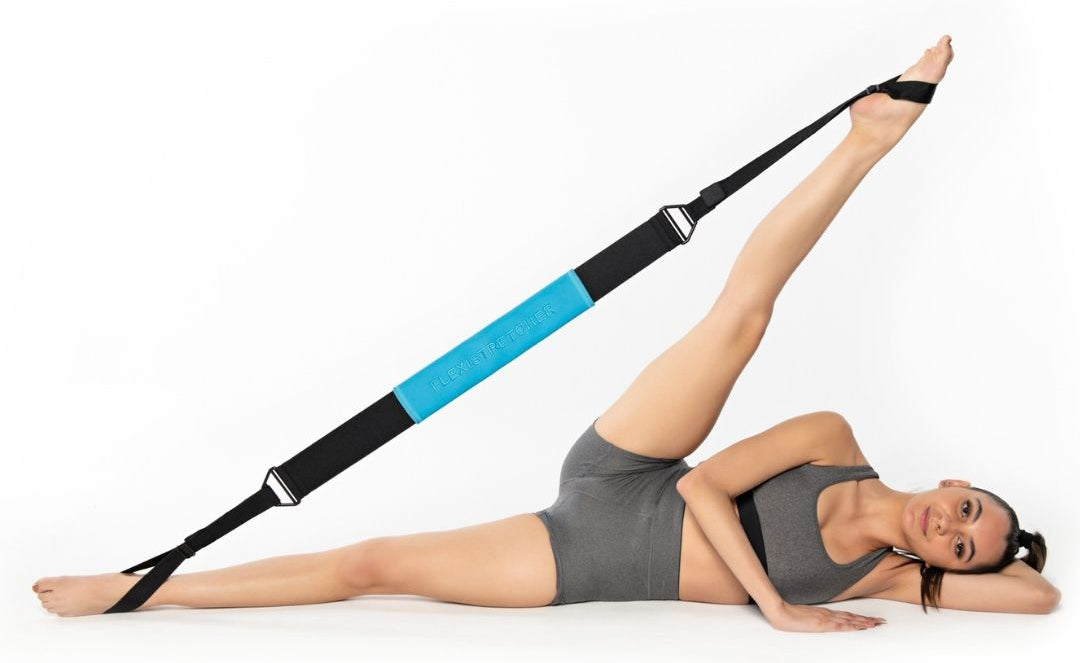The Hip Complex: Preventing Hip Pain

The hip has a multitude of functions. It flexes, extends, rotates internally and externally. With complex movement patterns, there are several small muscles that need extra attention to keep the hip in alignment. Hip pain can be caused by muscle imbalances, overuse and strained muscles, especially in women.
The strongest movements of the hip are flexion and extension. They are the focus of many workouts including biking, walking, running and many strength training movements. The weakest movements of the hip are internal and external rotation, abduction, adduction or side to side movements. To prevent misalignment and hip pain, focusing on the smaller hip muscles is important.
These are 6 exercises you can do with the Flexistretcher® to safely strengthen the smaller muscles of the hip and help prevent hip pain.
1. Seated Turnout - Starting with the Flexistretcher® neoprene cover and elastic center wrapped around the waist, securely place each strap around the balls of the feet. With legs extended, you should feel slight tension on the underside of the legs. Slowly turn feet out to the sides and return to center. Perform 10-15 reps. This exercise focuses on external hip rotation which helps with balance and alignment for walking and standing. Be sure to sit tall with sit’s bones grounded to the floor and head lifted.
2. Plie Seated Pushes - Starting with the Flexistretcher® neoprene cover and elastic center wrapped around the waist, securely place each strap around the balls of the feet. With legs slightly bent, you should feel slight tension on the underside of the legs. Slowly turn feet out to the sides and bend the knees. Push and extend the legs against the elastic resistance. Perform 10-15 reps. This exercise focuses on external hip rotation, the glutes, and quads. Be sure to sit tall with sit’s bones grounded to the floor and head lifted.
3. Side Leg Lifts - Start lying on your side with legs stacked and lift the rib cage by having your arm in a bent elbow on the ground. Place your Flexistretcher® elastic center on the foot and press into the elastic center keeping the leg straight. Hands should hold in place as the leg lifts and lowers. Perform 10-15 reps and repeat on the other side.
*Option to modify the side lying position to a side lying knee plank.
4. Side Leg Push Backs - Start lying on your side with legs stacked and lift the rib cage by having your arm in a bent elbow on the ground. Place your Flexistretcher® elastic center on the foot and press into the elastic center keeping the leg straight. Hands should hold in place as the knee bends and pushes back straight. Perform 10-15 reps and repeat on the other side.
*Option to modify the side lying position to a side lying knee plank.
5. Lunge with Reach - Start in lunge position with the Flexistretcher® overhead holding onto the nylon straps or rings. Keep tension in the arms pushing outward to help align posture. Perform a stationary lunge 15 times. Option to bend arms on the lower and straighten on the lift for added strengthening for the upper back. It’s essential to keep tension in the Flexistretcher® by pulling outward throughout the movement.
6. High Lunge Stretch- Start in runner’s lunge position (front knee bent and back leg straight with hips square to the front and both feet pointing forward), with the Flexistretcher® overhead holding onto the nylon straps or rings depending on your arm length and strength. Inhale as you press hips forward into the lunge and exhale as you reach upper back backwards by lifting the rib cage and chest. It’s essential to keep tension in the Flexistretcher® by pulling outward throughout the movement. Hold stretch for 10-15 seconds on each side. Return to plank and repeat alternating side for 20 times.
By strengthening and stabilizing the muscles in and around the hip, you can improve the ability in which the hip absorbs shock and helps alleviate hip pain. Improving hip strength can also help relieve some knee and lower back pain since these areas work and function together. For more stretch and strength exercises you can do at-home, visit @Flexistretcher® on IGTV and Rethink the Way You Stretch™.




Leave a comment